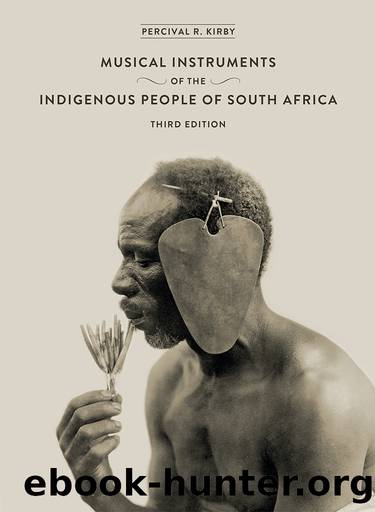The Musical Instruments of the Indigenous People of South Africa by Kirby Percival;

Author:Kirby, Percival;
Language: eng
Format: epub
Publisher: Wits University Press
Published: 2015-09-15T00:00:00+00:00
The set of three âtrillingâ reeds, played by one man, were sounded thus:
The set of six âtrillingâ reeds, played by one man, were sounded thus:
The additional reeds (consisting of duplicated and added sounds) in order of sounding on the record gave the following notes :
The full scale of reed-flutes was therefore:
the sounds of the six principal (and, in my opinion, original) flutes, being shown as minims. But although the flutes were tuned in this manner when sounded separately, Mrs. Hoernlé stated that, during the dances, the players would frequently step out of the circle and retune their flutes. This would explain why in the transcription of the reed-dance tune which follows, D and A natural appear. The harmonic scheme of the tune required those sounds. As the details of the âtrillsâ were far from clear, although the outline was easily discernible, I have transcribed the latter only. The remaining lines of the score represent all the other sounds that could be distinguished. The whole appears to me to show very definite European influence.
It is very unfortunate that no record is available of the use of the six principal flutes alone, marked in the following score with an asterisk. It would have proved of the greatest value, since among the Hottentots the ensemble is almost extinct, and where it lingers is no longer pure. However, reference to the Chwana use of the reed-flutes shows that the original Hottentot tuning was adopted by them along with the flutes, and it is still in use. The early Hottentot dance-tunes were therefore probably of a very similar nature (vide p. 208).
The earliest reference to the use of the reed-flutes by the Korana Hottentots is that of Wikar (1778â9).23 He described the flutes as being made out of thick or thin reed, wound round with some substance which he does not name, and âmostly open at both ends [sic] although they are often closed at the lower end below the middleâ. Wikarâs error is easily explained by the fact that when the tuning-plug is pushed far up the tube, the lower end appears to be open as well as the top. The pipes, he said, were blown in skilful harmony. He also described the nature of the dance, which was similar to those of the Nama already referred to, and he showed how these Korana reed-dances were likewise of a dramatic character. Finally he pointed out for the first time that in such dances there was sometimes a courtship âmotif â. Archbell (1827â33),24 a Wesleyan missionary, made a bare mention of the âwhistling reedâ of the Korana, but the German missionary Zerwick (1855)25 wrote a very interesting description of the reed-dance among the âSpringbokâ and âCatâ tribes of the Korana Hottentots living near his mission station at Pniel.
Download
This site does not store any files on its server. We only index and link to content provided by other sites. Please contact the content providers to delete copyright contents if any and email us, we'll remove relevant links or contents immediately.
The Goal (Off-Campus #4) by Elle Kennedy(13203)
Kathy Andrews Collection by Kathy Andrews(11328)
Diary of a Player by Brad Paisley(7270)
What Does This Button Do? by Bruce Dickinson(5933)
Assassin’s Fate by Robin Hobb(5856)
Big Little Lies by Liane Moriarty(5517)
Altered Sensations by David Pantalony(4868)
Pale Blue Dot by Carl Sagan(4620)
Sticky Fingers by Joe Hagan(3913)
The Death of the Heart by Elizabeth Bowen(3342)
The Heroin Diaries by Nikki Sixx(3322)
Beneath These Shadows by Meghan March(3151)
Confessions of a Video Vixen by Karrine Steffans(3101)
The Help by Kathryn Stockett(3021)
How Music Works by David Byrne(2965)
Jam by Jam (epub)(2880)
Harry Potter 4 - Harry Potter and The Goblet of Fire by J.K.Rowling(2805)
Strange Fascination: David Bowie: The Definitive Story by David Buckley(2702)
Petty: The Biography by Warren Zanes(2575)
